Tom Parkinson's monthly column, introducing the diverse range of flora and fauna on show at Sanctuary Lakes.
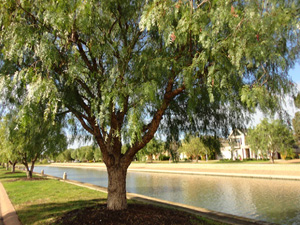 One of the great successes of the Sanctuary Lakes plantings has been the wonderful growth of trees around the resort. Photographs pre-development show a very barren acreage of salt ponds and low scrub with only the copse of River Gums trees, which now guard the entrance, standing out. Compare that with today’s hundreds of beautiful Chinese Poplars (Populous Simonal) and Apple Myrtle (Angophora Costata) that line the Northern and Southern Boulevards. Trees are a vital side to Natures Rubik; they attract bees, wasps, insects and flies that in turn attract the birds searching for food and shelter, all of whom in turn assist proliferating the trees through pollination and seed dispersal. Winter often brings a quietness to nature, but there are trees in Sanctuary Lakes that positively shine through the winter chills and in this month’s Natures Rubik we look at three tree species that almost glow during winter.
One of the great successes of the Sanctuary Lakes plantings has been the wonderful growth of trees around the resort. Photographs pre-development show a very barren acreage of salt ponds and low scrub with only the copse of River Gums trees, which now guard the entrance, standing out. Compare that with today’s hundreds of beautiful Chinese Poplars (Populous Simonal) and Apple Myrtle (Angophora Costata) that line the Northern and Southern Boulevards. Trees are a vital side to Natures Rubik; they attract bees, wasps, insects and flies that in turn attract the birds searching for food and shelter, all of whom in turn assist proliferating the trees through pollination and seed dispersal. Winter often brings a quietness to nature, but there are trees in Sanctuary Lakes that positively shine through the winter chills and in this month’s Natures Rubik we look at three tree species that almost glow during winter.
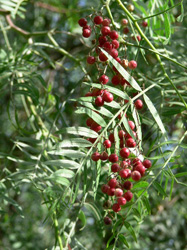 First up, the splendid guardians that line our Grand Canal Boulevard and the parallel Sandy Point Road, the Pepper Tree (Schinus Molle) - an evergreen tree, native to Peruvian Andes. It is also known as the Peruvian or Californian Pepper Tree. It was collected by Spanish (Franciscans) colonials who distributed the trees by seed into California and thence across the Pacific to Australia. Belonging to the Cashew family, the Pepper Tree is a fast growing evergreen tree that grows to 15 meters tall and 5-10 meters wide. The branches of the tree with their shiny pinnately compound leaves, have a characteristic tendency to droop. Being a dioeciously tree, male and female flowers will occur on separate plants. The flowers are small, white and borne profusely in panicles at the ends of the drooping branches.
First up, the splendid guardians that line our Grand Canal Boulevard and the parallel Sandy Point Road, the Pepper Tree (Schinus Molle) - an evergreen tree, native to Peruvian Andes. It is also known as the Peruvian or Californian Pepper Tree. It was collected by Spanish (Franciscans) colonials who distributed the trees by seed into California and thence across the Pacific to Australia. Belonging to the Cashew family, the Pepper Tree is a fast growing evergreen tree that grows to 15 meters tall and 5-10 meters wide. The branches of the tree with their shiny pinnately compound leaves, have a characteristic tendency to droop. Being a dioeciously tree, male and female flowers will occur on separate plants. The flowers are small, white and borne profusely in panicles at the ends of the drooping branches.
The fruits turn from green to red, pink or purplish, growing in dense clusters of hundreds of berries that can be present year-round. The trunk is a rough greyish bark that with age will gnarl, twist and drip sap.
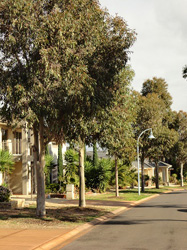 Spotted Gums in Water Stone Cove Although not related to the commercial pepper vine (Piper nigrum), the pink/red berries are sold as pink peppercorns in some speciality food shops. If you want to try a tasting, simply dry the berries till hard then pass through the grinder. Not as sharp as commercial pepper, but a talking point for any social foodie occasion.
Spotted Gums in Water Stone Cove Although not related to the commercial pepper vine (Piper nigrum), the pink/red berries are sold as pink peppercorns in some speciality food shops. If you want to try a tasting, simply dry the berries till hard then pass through the grinder. Not as sharp as commercial pepper, but a talking point for any social foodie occasion.
The second of our winter trees is the Australian native Spotted Gum (Corymbia maculata). When seen naturally growing in a native forest, Spotted Gums are truly magnificent but they are equally as striking when planted as a group or in an avenue. They are triumphantly doing that, just off Skyward Drive in Water Stone Cove and around the corner in Beachview Parade.
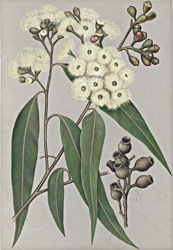 Corymbia maculata by Edward Minchen 1897 As can be seen, Spotted Gum is a tall, straight-trunked evergreen tree. It grows quite fast, reaching a height of over 25 metres. Spotted Gum has a smooth powdery bark which is white, grey or pink; often with characteristic patches ("the spotted").
Corymbia maculata by Edward Minchen 1897 As can be seen, Spotted Gum is a tall, straight-trunked evergreen tree. It grows quite fast, reaching a height of over 25 metres. Spotted Gum has a smooth powdery bark which is white, grey or pink; often with characteristic patches ("the spotted").
The crown is rounded and spreading with a moderately dense canopy. Profuse honey-scented white flowers are appearing now and will continue through to spring, when they start to fall, leaving an urn-shaped, woody fruit capsules. As the flowers bloom heavily through the winter they are a magnet for bees and insects who have lost their normal food sources which in turn attracts the honey eating and fly-catching birds. It also attracts the honey scent flowers and the later woody capsules attracts Rainbow Lorikeets. They particularly enjoy the high canopy not only as a dining room but as a play area.
There are two mammals, the Koala and the Sugar Glider, who in the native forests, target the Spotted Gums as a favourite home base. So far neither have moved into our neighbourhood, but you never know with the proliferation of Spotted Gums and that winter honey perfume travels many kilometres.
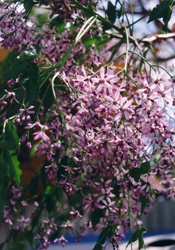 Our third Tree is the White Cedar (Melia Azedarach), one of Australia few winter deciduous trees. You can see them in Swingers Lane and on the corner of Swingers Green and Greg Norman Drive opposite the Kids Resort. They are also starting to establish in Scenic Drive Park and Rhode Island Point. In all seasons the White Cedar is a beautiful ornamental tree. Starting in September/October and just as the new glossy leaves emerge, the tree starts flowering and may continue to do so into summer. It’s worth viewing this tree for the spring show alone.
Our third Tree is the White Cedar (Melia Azedarach), one of Australia few winter deciduous trees. You can see them in Swingers Lane and on the corner of Swingers Green and Greg Norman Drive opposite the Kids Resort. They are also starting to establish in Scenic Drive Park and Rhode Island Point. In all seasons the White Cedar is a beautiful ornamental tree. Starting in September/October and just as the new glossy leaves emerge, the tree starts flowering and may continue to do so into summer. It’s worth viewing this tree for the spring show alone.
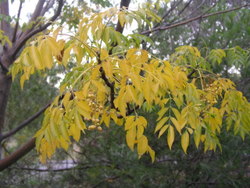 The starry lilac and white flowers appear in beautiful clusters. The flowers are also lightly fragrant, often described as chocolate-like nectar. While the flowers get most attention, the leaves are also a lovely feature of the tree. They are bi-pinnate – with many oval to elliptical leaflets, each from 20 to 70cm in length, that darken with age from the fresh, glossy green at emergence in spring. It really is a pleasure to sit under it, with all the leaflets dancing independently in a breeze.
The starry lilac and white flowers appear in beautiful clusters. The flowers are also lightly fragrant, often described as chocolate-like nectar. While the flowers get most attention, the leaves are also a lovely feature of the tree. They are bi-pinnate – with many oval to elliptical leaflets, each from 20 to 70cm in length, that darken with age from the fresh, glossy green at emergence in spring. It really is a pleasure to sit under it, with all the leaflets dancing independently in a breeze.
In April/May, the leaves turn an iridescent lemon yellow and the now purple flowers fall leaving large clustered bunches of rich orange seeds which give the White Cedar a “must see” look for winter.
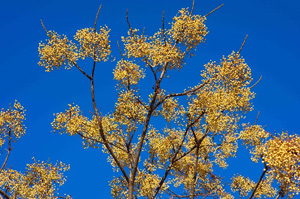 The seeds are hard when dried correctly, making them very desirable for use in arts and craft work particularly beads, including rosary beads. One word of warning - the seeds if eaten by humans and animals can be very toxic, although birds are able to eat the fruits. In fact they are very partial and gorge upon them, thus dispersing the seed through their droppings.
The seeds are hard when dried correctly, making them very desirable for use in arts and craft work particularly beads, including rosary beads. One word of warning - the seeds if eaten by humans and animals can be very toxic, although birds are able to eat the fruits. In fact they are very partial and gorge upon them, thus dispersing the seed through their droppings.
These are just three of the trees that are shining this winter in Sanctuary Lakes. If you are looking at stretching your legs this weekend, try to make a viewing of these magnificent plants.